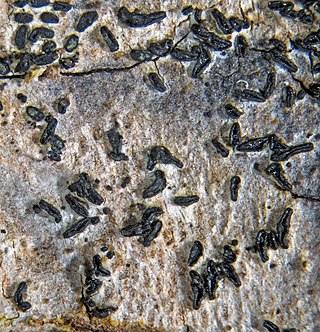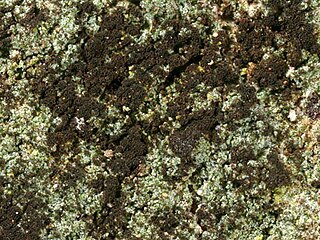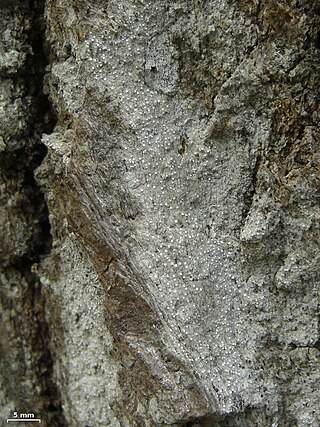
The Arthoniaceae are a family of lichenized, lichenicolous and saprobic fungi in the order Arthoniales. The Arthoniaceae is the largest family of Arthoniales, with around 800 species. Most species in Arthoniaceae belong in Arthonia which is the largest genus with 500 species. The second and third largest genus is Arthothelium with 80 species, and Cryptothecia with 60 species.

Micarea is a genus of lichenized fungi in the family Pilocarpaceae. The widely distributed genus contains 126 species and new species are described actively. Species in the genus are crustose lichens and their photobiont is a single-celled green alga.

Chiodecton is a genus of lichens in the family Roccellaceae. The genus was circumscribed by lichenologist Erik Acharius in 1814, with Chiodecton sphaerale assigned as the type species.

Lecanactis is a genus of crustose lichens, commonly called old wood rimmed lichen. The genus was circumscribed in 1855 by German lichenologist Gustav Wilhelm Körber, who assigned Lecanactis abietina as the type species.

Syncesia is a genus of lichen-forming fungi in the family Roccellaceae.
Tylophoron is a genus of lichen-forming fungi in the family Arthoniaceae. The genus was circumscribed in 1862 by Finnish lichenologist William Nylander.
Synarthonia is a genus of lichen-forming fungi in the order Arthoniales. The genus has not been placed into a family. Synarthonia was circumscribed by Swiss lichenologist Johannes Müller Argoviensis in 1891.

Alyxoria is a genus of lichen-forming fungi in the family Lecanographaceae.

Lecanographaceae is a family of mostly lichens in the order Arthoniales. The family was circumscribed in 2014, prompted by a molecular phylogenetic-based restructuring of the Arthoniales.
Crypthonia is a genus of lichen-forming fungi in the family Arthoniaceae. It has 16 species. The genus was circumscribed in 2010 by Andreas Frisch and Göran Thor, with Crypthonia polillensis assigned as the type species.
Myriostigma is a genus of lichens in the family Arthoniaceae. The genus was circumscribed by German lichenologist August von Krempelhuber in 1874.
Inoderma sorediatum is a species of crustose lichen in the family Arthoniaceae. It is only known to occur on the bark of trees in Poland's Białowieża National Park. It is differentiated from other species in genus Inoderma by the form of its thallus, which is entirely made of powdery, granular soredia, as well as by the presence of a unique combination of lichen products.

Reichlingia is a genus of lichen-forming fungi in the family Arthoniaceae. It has seven species. The genus was originally circumscribed by Paul Diederich and Christoph Scheidegger in 1996, with Reichlingia leopoldii as the type, and at that time, only species. The fungus was at first thought to be a lichenicolous (lichen-dwelling) fungus, but is now considered a lichenised hyphomycete.
Ocellomma is a genus of lichen-forming fungi in the family Roccellaceae. The genus was circumscribed in 2014 by Damien Ertz and Anders Tehler, following a molecular phylogenetic-based revision of the Roccellaceae. The type species, O. picconianum, was originally named Lecania picconiana by Francesco Baglietto in 1862, described from specimens collected in Italy. DNA-based phylogenetic analysis showed that it occupied a distinct genetic lineage, deserving of recognition as a new genus. The genus name Ocellomma alludes to the whitish rims on the small ascomata that contrast with the discs, giving them the appearance of small eyes.
Galbinothrix is a fungal genus in the family Chrysotrichaceae. It is monotypic, containing the single species Galbinothrix caesiopruinosa, a corticolous (bark-dwelling) lichen.

Fulvophyton is a genus of lichen-forming fungi in the family Roccellographaceae. It has 11 species. Fulvophyton is characterised by its crust-like thallus, which is often pale yellowish-brown in colour. This genus features a photobiont from the green algal genus Trentepohlia and exhibits a unique arrangement of reproductive structures.

Sporodophoron is a genus of lichen-forming fungi in the family Arthoniaceae. It includes four corticolous (bark-dwelling) crustose lichen species. Sporodophoron is uniquely characterised by the formation of structures called sporodochia, which are open conidiomata in the form of tufts of conidiophores on the thallus. Although these lichens bear a strong resemblance to Inoderma, another genus within the same family, Sporodophoron's distinct chemical makeup sets it apart from its lichen relatives. Collectively, the genus has a widespread geographical distribution in the Northern Hemisphere, with species found in distinct habitats in North America, Europe, Japan, and the Russian Far East.
Sporodophoron primorskiense is a little-known species of corticolous (bark-dwelling) lichen in the family Arthoniaceae. It is notable for its distinctive white, thin growth patterns and small sporodochia, or spore-producing structures. The species is named after the Primorsky Krai region in the Russian Far East, where it was first discovered. It has since been recorded in Japan.

Coniocarpon is a genus of lichen-forming fungi in the family Arthoniaceae. It has eight species of corticolous (bark-dwelling) lichens. This genus is distinct for its crystalline orange, red, and purple quinoid pigments in the ascomata that turn purple in potassium hydroxide solution, its colourless, transversely septate ascospores with large apical cells, and its rounded to lirellate ascomata.










